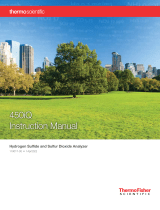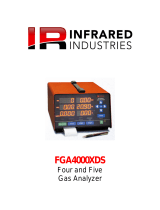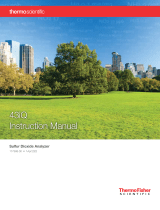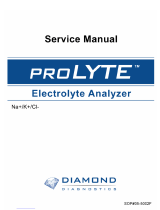Page is loading ...

MODEL 6200A
TRS ANALYZER
MANUAL ADDENDUM
TELEDYNE ANALYTICAL INSTRUMENTS
03655 Rev. A, August, 2000

TAI - Thermal Converter Operator Manual - Page i
TABLE OF CONTENTS
TABLE OF CONTENTS
..............................................................................................
I
TABLE OF FIGURES
...................................................................................................
I
1.0 WARRANTY
............................................................................................................
1
1.1 Claims for damaged shipments
..................................................................................
2
1.2 Claims for shipping discrepancies
.............................................................................
2
2.0 INTRODUCTION
....................................................................................................
3
2.1 Specifications
.............................................................................................................
3
2.1.1 Analyzer Specifications
..................................................................................
3
2.1.2 TRS Converter Specifications
.........................................................................
3
2.2 The Sulfides Analyzer
...............................................................................................
4
2.3 Configurations
............................................................................................................
4
2.4 The TRS – Total Reduced Sulfur Converter
..............................................................
8
2.5 Installation
..................................................................................................................
10
2.6 Operation and Calibration
..........................................................................................
12
2.6.1 Calibration Theory
..........................................................................................
12
2.6.2 Zero and Span Calibration Procedure
.............................................................
13
2.7 M501TRS Temperature Controller
............................................................................
14
2.7.1 Changing the Temperature Set Point
..............................................................
14
2.7.2 Adjusting the P-I-D Parameters
......................................................................
15
3.0 TROUBLESHOOTNG
............................................................................................
17
4.0 MAINTENANCE
.....................................................................................................
19
4.1 SO2 Analyzer Maintenance
.......................................................................................
19
4.2 Changing the Quartz Tube
.........................................................................................
19
4.3 Checking the Converter Efficiency
............................................................................
19
4.4 Sample Diluter Maintenance
......................................................................................
20

TAI - Thermal Converter Operator Manual - Page i
TABLE OF FIGURES
FIGURE 2.1 – STANDARD CONFIGURATION 5
FIGURE 2.2 – WITH IZS OPTION 6
FIGURE 2.3 – WITH M702 CALIBRATOR OPTION 7
FIGURE 2.4 – TRS CONVERTER LAYOUT 9
FIGURE 2.5 – PNEUMATIC CONNECTIONS 11
FIGURE 3.1 – TRS WIRING DIAGRAM 18
FIGURE 4.1 – DILUTER FLOW BLOCK ASSEMBLY 21

TAI - Thermal Converter Operator Manual - Page i
TABLE OF TABLES
TABLE 2.1 – TRS CONVERTER SPECIFICATIONS
.............................................................................................................
3
TABLE 2.2 – ZERO CALIBRATION PROCEDURE
..............................................................................................................
13
TABLE 2.3 – SPAN CALIBRATION PROCEDURE
..............................................................................................................
14
TABLE 2.4 – TEMPERATURE CONTROLLER - INITIAL SETTINGS
...............................................................................
16
TABLE 2.5 – TEMPERATURE CONTROLLER - SECONDARY MENU
............................................................................
16

TAI - Thermal Converter Operator Manual - Page 1
1.0 WARRANTY
TELEDYNE ANALYTICAL INSTRUMENTS
02024c
Prior to shipment, TAI equipment is thoroughly inspected and tested. Should equipment failure occur, TAI
assures its customers that prompt service and support will be available.
COVERAGE
After the warranty period and throughout the equipment lifetime, TAI stands ready to provide on-site or in-
plant service at reasonable rates similar to those of other manufacturers in the industry. All maintenance
and the first level of field troubleshooting are to be performed by the customer.
GENERAL
TAI warrants each Product manufactured by TAI to be free from defects in material and workmanship under
normal use and service for a period of one year from the date of delivery. All replacement parts and repairs
are warranted for 90 days after the purchase.
If a Product fails to conform to its specifications within the warranty period, TAI shall correct such defect
by, in TAI's discretion, repairing or replacing such defective Product or refunding the purchase price of such
Product.
The warranties set forth in this section shall be of no force or effect with respect to any Product:
(i) that has been altered or subjected to misuse, negligence or accident, or (ii) that has been used in any
manner other than in accordance with the instruction provided by TAI or (iii) not properly maintained.
THE WARRANTIES SET FORTH IN THIS SECTION AND THE REMEDIES THEREFORE ARE
EXCLUSIVE AND IN LIEU OF ANY IMPLIED WARRANTIES OF MERCHANTABILITY, FITNESS
FOR PARTICULAR PURPOSE OR OTHER WARRANTY OF QUALITY, WHETHER EXPRESSED
OR IMPLIED. THE REMEDIES SET FORTH IN THIS SECTION ARE THE EXCLUSIVE REMEDIES
FOR BREACH OF ANY WARRANTY CONTAINED HEREIN. TAI SHALL NOT BE LIABLE FOR
ANY INCIDENTAL OR CONSEQUENTIAL DAMAGES ARISING OUT OF OR RELATED TO THIS
AGREEMENT OF TAI'S PERFORMANCE HEREUNDER, WHETHER FOR BREACH OF
WARRANTY OR OTHERWISE.
TERMS AND CONDITIONS
All units or components returned to TAI should be properly packed for handling and returned
freight prepaid to the nearest designated Service Center. After the repair, the equipment will be
returned, freight prepaid.

TAI - Thermal Converter Operator Manual - Page 2
1.1 Claims for damaged shipments
All instruments should be thoroughly inspected immediately upon receipt. Material in the container
should be checked against the enclosed packing list. If the contents are damaged and/or the instrument
fails to operate properly, the carrier and TAI should be notified immediately.
The following documents are necessary to support claims:
•
Original freight bill and bill of lading
•
Original invoices or photocopy of original invoice
•
Copy of the packing list
•
Photographs of damaged equipment and container
1.2 Claims for shipping discrepancies
All containers should be checked against packing list immediately upon receipt. If a shortage occurs,
notify the carrier and TAI immediately. TAI will not be responsible for shortages against the packing list
unless they are reported immediately.
The following information is necessary to make a claim:
•
The instrument model number
•
Serial number
•
Sales order number or purchase order number
Upon receipt of a claim, TAI will advise disposition of the equipment for repair or replacement.

TAI - Thermal Converter Operator Manual - Page 3
2.0 INTRODUCTION
This manual addendum should be used in conjunction with the standard Model 6200A.
2.1 Specifications
2.1.1 Analyzer Specifications
The specifications for the SO2 analyzer are contained in the standard Model 6200A manual.
2.1.2 M501TRS Converter Specifications
TABLE 2.1 – M501TRS Converter Specifications
Specification Value Unit
Flow Rate 1000 Cc/min maximum
TRS Concentration 20 ppm
Converter Temperature 950 – 1050
o
C
Dilution Ratio 4.3:1 Number
Conversion Eff. (H2S) >98 %
Power 220 VAC, 50/60 Hz, 220 watts
Weight 24 lbs
11 kg
Dimensions 7 x 17 x 22 inches
178 x 432 x 559 mm

TAI - Thermal Converter Operator Manual - Page 4
2.2 The 6200A Sulfides Analyzer
The TAI Model 6200A Sulfides Analyzer, is designed to measure mixed sulfur impurities, collectively
referred to as TRS, in carbon dioxide (CO2) gas. Since there is no SO2 scrubber in the system, the
instrument reading is the sum of the reduced sulfur compounds and SO2. The 6200A consists of a
modified 6200A UV Fluorescence SO
2
Analyzer and a M501TRS high temperature quartz converter.
The M501TRS converts sulfur compounds to SO
2
at high temperature by flowing the gas through a hot
quartz tube, the resultant reaction is as follows:
TRS + O
2
--> SO
2
Since the gas being analyzed is CO2, which generally contains no oxygen, there is an assembly that injects
a small amount of air into the sample stream resulting in about 4% oxygen in the sample. The added
oxygen allows the sulfur compounds to be oxidized to SO2. Any SO2 present in the sample is unaffected
by the converter. The sample gas then passes to a modified 6200A analyzer where the converted
compounds are analyzed as SO
2
.
2.3 Configurations
There are three configurations available:
1.
The standard unit consisting of:
•
A modified 6200A Fluorescent SO2 Analyzer
•
A M501TRS High Temperature Converter
•
See Figure 2.1 for the pneumatic diagram
2.
The standard unit described above plus:
•
An Internal Zero/Span (IZS) Option with H2S permeation tube
•
The IZS option uses sample gas, passed through a charcoal scrubber to dilute H2S from
the perm tube plus a converter bypass valve to assure a high quality zero/span
calibration.
•
See Figure 2.2 for the pneumatic diagram
3.
The standard unit described above plus:
•
An external PRC-6000 calibrator for blending tanks of H2S or SO2 span gas with CO2.
•
See Figure 2.3 for the pneumatic diagram

TAI - Thermal Converter Operator Manual - Page 5
FIGURE 2.1 – BASIC CONFIGURATION

TAI - Thermal Converter Operator Manual - Page 6
FIGURE 2.2 – WITH IZS OPTION

TAI - Thermal Converter Operator Manual - Page 7
FIGURE 2.3 – WITH M702 CALIBRATOR OPTION

TAI - Thermal Converter Operator Manual - Page 8
2.4 The M501TRS – Total Reduced Sulfur Converter
The M501TRS oxidizes reduced sulfur compounds to SO2 in a high temperature quartz oven.
Power to the heater is controlled by a front panel mounted programmable temperature controller. Power
to the heater is switched by a solid state switch. An over-temperature alarm contact closure is located on
the rear panel. The alarm set point is adjustable in the temperature controller. The heater temperature is
sensed by a Type K (chromel-alumel) thermocouple probe inserted in the bore alongside the quartz tube.
The quartz tube carrying the sample mixture runs through the core of the heater and is heated by radiation
from electrical heating elements at the heater bore surface. See Figure 2.4 for a layout view of the
converter.
WARNING !
INSURE PROPER LINE VOLTAGE IS SELECTED PRIOR
TO PLUGGING UNIT INTO POWER SOURCE.
WARNING !
THE QUARTZ TUBE AND HEATER ARE VERY HOT
DO NOT TOUCH

TAI - Thermal Converter Operator Manual - Page 9
FIGURE 2.4 – TRS CONVERTER LAYOUT

TAI - Thermal Converter Operator Manual - Page 10
2.5 Installation
The 6200A comes in two chassis. There is a power cord for each that should be plugged into the correct
voltage and frequency receptacle. See the tag on the rear panel of each chassis for the voltage and
frequency settings. The power connection must be made by an approved three-wire-grounded power cord.
The pneumatic connections are shown in Figure 2.5.
•
Connection to the TRS analyzer must be made with Teflon or stainless steel tubing.
•
Connect the sample inlet to the labeled fitting.
•
The sample exhaust must be routed to a well ventilated area away from the air inlet for the zero
air scrubber on the rear panel.
The overall pneumatic diagrams of the Model 6200A are shown in Figures 2.1, 2.2, and 2.3.
CAUTION !
DO NOT BLOCK THE SIDE AND BACK
VENTILATION OF THE M501TRS
CONVERTER

TAI - Thermal Converter Operator Manual - Page 11
FIGURE 2.5 – PNEUMATIC CONNECTIONS

TAI - Thermal Converter Operator Manual - Page 12
2.6 Operation and Calibration
Refer to the 6200A manual for the overall operation of the SO2 analyzer. This unit has some unique
operating characteristics and calibration procedures detailed below.
2.6.1 Calibration Theory
The basic purpose of this instrument is to analyze CO2 sample gas for sulfur containing impurities.
Unlike similar analysis, there is not any zero air available. The following procedure will to allow the
instrument to be zeroed and spanned using the CO2 sample gas that may contain impurities.
The CO2 gas used for zero air is routed from the sample inlet through a charcoal scrubber to remove any
SO2 present.
This gas then passes through the converter and into the reaction cell for measurement. When the signal is
stable, the value Z1 is stored.
Since there are numerous other sulfur containing gasses, it is not possible to determine how well the
charcoal will scrub compounds other than SO2. A 3-way valve is used to bypass the M501TRS converter,
so the sample gas now passes through a charcoal scrubber, then directly to the reaction cell.
The instrument is allowed to collect data with the converter bypassed and this reading is stored as Z2.
This is the actual instrument zero reading.
Span calibration uses span gas generated by a H2S permeation tube, which has been diluted by scrubbed
CO2 described above.
During this phase, the converter MUST be in the pneumatic pathway so the H2S can be oxidized to SO2
and thus measured. However, the converter will not only convert the H2S, but also any impurities that
were not scrubbed by the charcoal, thus producing an anomalously high reading. (If there is no additional
impurities in the CO2 gas, the correction factor will be zero.)
To correct for this error, the software computes a span correction by the following equation:
Z3 = Z1 - Z2
Where:
Z2 = Zero reading with the converter bypassed.
Z1 = Zero reading with the converter in place
Z3 = Zero gas impurity correction factor

TAI - Thermal Converter Operator Manual - Page 13
When the span gas reading stabilizes, Z3 is subtracted from the span reading, yielding the actual H2S span
gas value as follows:
[H2S]
Actual
= [H2S]
Apparent
– Z3
Where:
Z3 = Zero gas impurity correction factor
[H2S]
Apparent
= Analyzer response to H2S perm tube + impurities in the zero air.
[H2S]
Actual
= H2S span reading corrected for impurities in zero air.
The [H2S]
Actual
is the reading used to compute the span concentration.
2.6.2 Zero and Span Calibration Procedure
The following is a concise summary of the steps required to zero and span calibrate the 6200A. Please
refer to the standard 6200A manual for a more complete description of the calibration procedure.
Table 2.2 – Zero Calibration Procedure
Step
Number
Action Comment
1.
Press CALZ With sample gas flowing into the sample inlet of the
instrument, press CALZ, which routes sample air into the
charcoal scrubber.
2. Press ZERO ZERO starts Phase 1 of the zero calibration procedure,
allowing zero to be measured with the converter in the
pneumatic pathway. Allow 10 min for stable zero.
3.
Press ENTR
After allowing the instrument to stabilize, press ENTR, to
store the Z1 zero value with the converter in the pathway.
The ZERO key now re-appears, which starts Phase 2
of the zero calibration. Allow 10 min for stable zero.
4. Press ENTR The converter is not in the pathway. Allow the
instrument to stabilize on the new zero value, then press
ENTR to store the Z2 zero value.
5.
Press EXIT
Returns instrument to SAMPLE mode.

TAI - Thermal Converter Operator Manual - Page 14
Table 2.3 – Span Calibration Procedure
Step
Number
Action Comment
1.
Press CALS With sample gas flowing into the sample inlet of the
instrument, press CALS, which routes sample air into the
charcoal scrubber, then over the H2S permeation tube.
2. Press SPAN With the converter in the pathway, the instrument will
respond to H2S from the perm tube plus any impurities in
the zero air.
3.
Press ENTR
After allowing the instrument to stabilize, press ENTR.
The instrument will use the span reading, corrected for
impurities, to compute the actual H2S span value.
4.
Press EXIT
Returns instrument to SAMPLE mode.
2.7 M501TRS Temperature Controller
The heater temperature is maintained by a front panel-mounted programmable controller. The “Fuji
Electric PXZ Series Operation Manual” is included with the documentation for this instrument. The
controller has been set up at the factory. Should further adjustments be necessary, a brief summary of the
operation of the controller is included.
By pressing the PV/SV button in the lower left corner of the controller, you can see the Present Value
“PV” (actual temperature) or the Set Value “SV” (Set point Value).
2.7.1 Changing the Temperature Set Point
The temperature can be adjusted to optimize conversion efficiency, follow these steps:
1. Select SV with the PV/SV button,
2. Select the Set-Point value at approximately 960
o
C by Press the "up-arrow" under the digit you
want to change, (the digit will flash).
NOTE:
DO NOT SET THE TEMPERATURE HIGHER THAN 1050
O
C

TAI - Thermal Converter Operator Manual - Page 15
3. Press the "up-arrow" under the digit or the "down-arrow" at the left to scroll the digit to the
desired value.
4. Repeat for the other two digits,
5. Press the ENTER button.
6. Select PV with the PV/SV button to observe the actual temperature. Allow temperature to
equilibrate for a minimum of 30 to 45 minutes.
2.7.2 Adjusting the P-I-D Parameters
In the event that the control parameters must be changed or in the event that a new controller is installed,
it must be reprogrammed to suit the thermal characteristics of the instrument. It is recommended that the
Auto Tune function be used to set the control functions if reprogramming is necessary.
The following table is a guide to the approximate values for setting the parameters that will produce the
initial settings for the autotune function. Below is a summary of the autotune procedure, refer to the Fuji
Manual for more detailed information.
To perform Auto Tune function, set the parameter A7 to 1, then press ENTER.
The controller will begin the autotune process, which takes several minutes. The decimal point at the
lower right of the display will blink, indicating the controller is autotuning. During the process, the
temperature may oscillate
±
100
o
C or more. When the process is completed, the decimal point will stop
blinking.
NOTE:
It is normal for the ceramic heating element to emit a red glow
at the operating temperature.

TAI - Thermal Converter Operator Manual - Page 16
Table 2.4 – Temperature Controller - Initial Settings
PRESS DISPLAY INITIAL VALUE
SEL
P PROP BAND
UP/DOWN SET TO “11”
SEL
i INTEGRAL
SET TO “10”
SEL
d DERIVATIVE TIME
SET TO “7.7”
SEL
AL LOW ALARM
SETPOINT
SET TO “50” (C BELOW FINAL SETPOINT)
SEL
AH HIHG ALARM
SETPOINT
SET TO “50” (C ABOVE FINAL SETPOINT)
SEL
7C CYCLE TIME
SET TO “2”
SEL
HYS HYSTERESIS
SET TO “3”
SEL
A7 AUTOTUNE
SET TO “0” (OFF)
SEL
LOC LOCK
“0” (OPEN) “1” (LOCKED)
“2” (SV ONLY OPEN)
Table 2.4 shows a Secondary Menu of parameters that set more basic parameters of the controller, these
include the thermocouple type, the temperature units etc.
Table 2.5 – Temperature Controller - Secondary Menu
PRESS DISPLAY PARAMETER VALUE
SEL HOLD TILL p-n1
SET TO “0”
SEL p-n2
SET TO “3” (TYPE K THERMOCOUPLE)
SEL
p-dF DIGITAL FILTER
SET TO “5”
SEL
P-SL LOWER LIMIT
SET TO “32” (32C)
SEL
P-SU UPPER LIMIT
SET TO “1050” (1050C)
SEL
P-AL ALARM TYPE2
SET TO “900”
SEL
P-AH ALARM TYPE 1
SET TO “1050”
SEL
P-An HYTERESIS
SET TO “3”
SEL
P-dP DECIMAL LOCATION
SET TO “0”
SEL
PVOF PROCESS OFFSET
LEAVE AT “0”
SEL
SVOF SET POINT OFFSET
LEAVE AT “0”
SEL
P-F
SET TO “ºC” (CENTIGRADE)
SEL
FUZZY FUZZY LOGIC
SET TO “ON”
/














